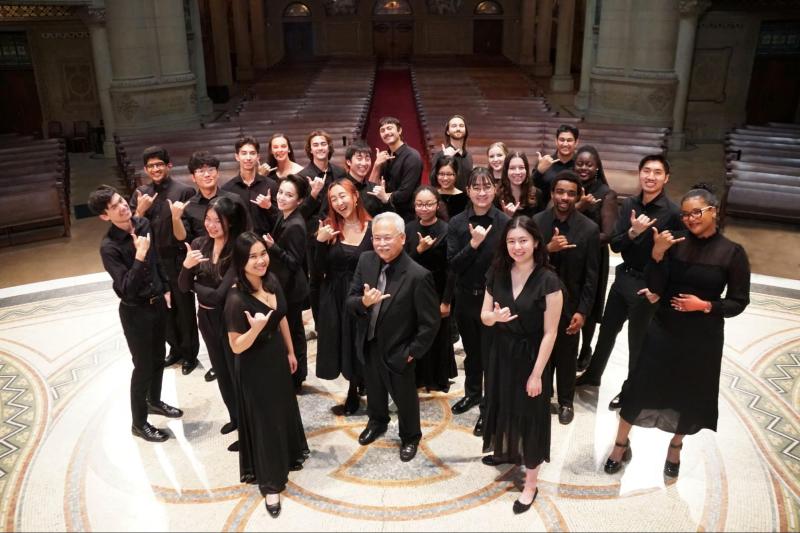Traveling over 2000 miles, music from Hawai‘i was brought to campus on Sunday at 2:30 p.m. by the Stanford Chamber Chorale with “Tour Aloha.” The ensemble prepared a diverse program of vocal music, ranging from classical music based on English poetry to songs by Queen Liliʻuokalani, the last sovereign to govern the Hawaiʻi islands.
The Stanford Chamber Chorale is the most selective group among the six choral ensembles in the Department of Music, according to Director of Choral Studies Stephen Sano, who also directs the chorale. The ensemble takes on projects like recordings and has achieved acclaim in their work. According to Sano, “the last three of our recordings were on the Grammy first-round ballot.”
The chorale is offered as a class, “MUSIC 165: Chamber Chorale,” and is composed of roughly equal numbers of undergraduate and graduate students. Despite each member ranging in their musical pursuits, the chorale still collectively attains a high caliber in performance.
“Most of us are not music majors,” said Cecilia La Puma ’25. “I think itʻs something unique to Stanford that we’re still able to perform at such a high level.”
The chorale plans to bring their Sunday program to Hawaiʻi over the upcoming spring break, visiting various locations on the Big Islands and Oahu. The ʻIolani Palace serves as an important setting for one of the works: “Kuʻu Pua I Paoakalani (My Flower at Paoakalani)” written by Queen Liliʻuokalani.
“Queen Liliʻuokalani was this incredible composer and had a real gift for melody,” Sano said. The chorale will perform “Kuʻu Pua I Paoakalani” in the room where Queen Liliʻuokalani composed it while she was under house arrest following the overthrow of her government. Sano describes the purpose of that performance as “honoring her, as well as the docents and staff in the palace”.
On top paying a meaningful tribute to the last reigning monarch of the kingdom of Hawai‘i, Trip Masters B.A. ’23 M.A. ’24 views both the chorale’s work and the setting of their performance as emotionally impactful.
“We’re able to do something really, really interesting and powerful that will honestly be pretty emotional,” Masters said. “I think that it’s much bigger than us.”
The chorale is also performing several songs from a more contemporary Hawaiian repertoire. Jin-Hee Lee B.A. ’23 M.A. ’24 especially enjoys “Pālehua,” a song that was a “huge hit in the ’90s when it came out,” according to Sano. Lee appreciates the beauty in the song’s simplicity and its communal feel.
“There are a lot of unisons in the voice parts, and we branch off and come together again,” Lee said. “It almost feels like we’re all holding each otherʻs hands while we’re singing it.”
Many songs were written and will be performed in Ōlelo Hawaiʻi, the indigenous language of Hawaiʻi. La Puma finds Ōlelo Hawaiʻi to be simultaneously challenging to memorize, yet facilitative for singing since the language has many vowels.
“The consonants serve as flag posts and help you remember differences between words,” La Puma said. “Luckily, when you forget the words, it’s not as hard to just blend in with the rest of the chorale; pick a vowel and you have a one-in-seven chance.”
While ensemble members may blend into vocal parts easily, their ability to blend into Hawaiian culture as visitors may present a challenge in light of recent controversy surrounding tourism in Hawai‘i. However, Sano’s cultural sensitivity and awareness puts ensemble members at ease.
“Steve has a really good understanding of how to ethically go to Hawaiʻi,” La Puma said. “He really focuses on being respectful of local cultures, and adding rather than taking away from them.”
While the program brings light to works composed by natives of Hawai‘i, composers of different backgrounds are also featured. For instance, the ensemble will be performing “Cello Songs” by American composer Jake Runestad, featuring the St. Lawrence String Quartet cellist and Stanford Artist-in-Residence Christopher Costanza along with Director of Collaborative Piano Laura Dahl.
Runestad’s composition includes four movements, each representing one of the four seasons. Collaborating with Costanza and Dahl has been a rewarding musical experience, according to Masters.
“[The piece] is really gorgeous,” Masters said. “When we were rehearsing with Chris and Laura, it was almost hard to focus because of how impressive [they are].”
The concert is planned to close out with an African American spiritual arrangement by composer and arranger Moses Hogan, who is “one of the icons of the genre,” according to Sano.
“It’s a wonderful, uniquely American style of choral singing,” Sano said. “The Chamber Chorale actually had the great privilege to work with him in a masterclass when he was still alive. And those things that he imparted to us still guide how I approach his music and that genre.”
The group typically goes on annual tours around the world, although their last tour to England was the first after an extended hiatus from touring because of the COVID-19 pandemic. As a student who was involved in the chorale for five years, Lee is excited to return to touring with the ensemble.
“We were actually supposed to go on the Aloha tour in my freshman year in 2020,” Lee said. “This is only my second tour, and I’m incredibly excited to connect with this rich, incredible Hawaiian culture with all my choir members.”
A previous version of this article misspelled Costanza’s and Liliʻuokalani’s last names. The Daily regrets this error.
